|
Read 13069879 times
Connect me to:
|
TOPICS INCLUDE: Tea amounts to drink; Animal tendons; Soy beans and soy foods; Silk squash and scrambled egg; Chinese population in Flushing; Medicines to take to China; Pineapple rice; Making Er Kuai after the recipesLetters to the Editor
Summer Volume: 2012 Issue: 19(2) page(s): 7 - 9, and 37
From BETSY via e-mail:
Read in a 'lady's magazine' that three cups is the minimum recommended daily amount of tea needed for benefits that include a healthier immune system, stronger bones, lower blood pressure, and reduced cholesterol. Is this true?
BETSY: Thanks for asking, but you should inquire of Family Circle who reported this in their October 17, 2011 issue. We are not tea researchers nor medical doctors. We read that, too, and the page you quote says it is "a roundup of smart talk, hot trends and cool stuff." We commend them for giving an amount of tea but they did not advise if green or black tea, nor how strong or weak the tea need be. Everyone should be upset when reading health information that does not share where its information comes from. Let us repeat, the page says "smart talk, hot trends and cool stuff." It also shows tea in caramels, chocolate, sorbet, and mints. Would that good health comes from foods such as those.
From MARRETTE via e-mail:
Do the Chinese cook any animal tendon besides those of the cow? If so, do you have a recipe for one or more of them?
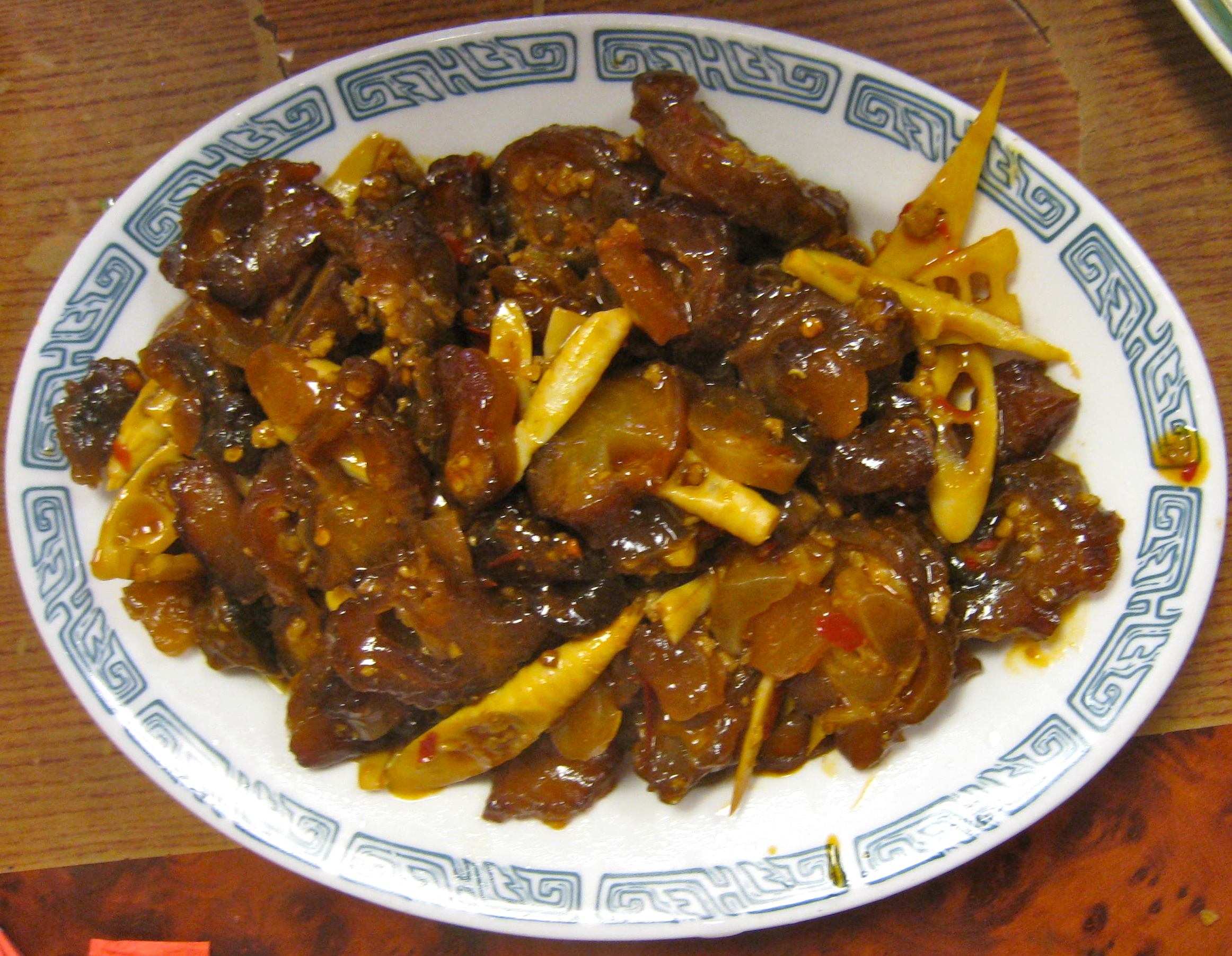 MARRETTE: Your question could not be more timely. Recently, at M & T Restaurant in Flushing, we ordered a dish with beef tendons but were told they only had pork tendons in house. Never had them from pig before, so we order that dish and learn they are delicious. A long time ago, we did eat deer tendon in China and did get a recipe for it in Xian. However, we never used it because we could not find any deer tendons on Long Island. Here is that recipe and another for a braised ox tendon dish we did make about a year ago. Enjoy both!
MARRETTE: Your question could not be more timely. Recently, at M & T Restaurant in Flushing, we ordered a dish with beef tendons but were told they only had pork tendons in house. Never had them from pig before, so we order that dish and learn they are delicious. A long time ago, we did eat deer tendon in China and did get a recipe for it in Xian. However, we never used it because we could not find any deer tendons on Long Island. Here is that recipe and another for a braised ox tendon dish we did make about a year ago. Enjoy both!
From KATY in Oregon:
Have two questions I hope you can answer. The first is where can we find extensive information about soy beans and soy foods? Can not seem to locate lots of valuable ones. The second is related to the first, and has to do with soy sauce being able to increase the flavors of foods. I can not find any information about that either.
KATY: The electronic soy database run by William Shurtleff and his wife Akiko Aoyagi in Lafayette California might help. They wrote many books, one of their earliest is The Book of Tofu. It sold more than three-quarters of a million copies; they also wrote The Book of Miso, The Book of Tempeh, Tofu & Soymilk Production, and many other related volumes. They manage this database, and have since 1972. They have a catalog, and we think they know more about soy than anyone else in the world. Check them out on the web at www.soyinfocenter.com
They have an 'in the works' comprehensive history of soy. This soon to be published volume will have more than two and a half thousand pages, more than eighty thousand references from 1100 BCE to date, etc. The database now includes research articles, commercial information, interviews, unpublished and archival materials, and more. Using it is not free, so contact them about your needs and their prices. Assume you know this legume is low in carbohydrates, high in good-quality protein, has valuable edible oil, and is one of the five sacred grains of China. The other four wu gu items are rice, wheat, barley, and millet. As to your second question, soy sauce does have glutamates and mushrooms have nucleotides. In Cooks Magazine they did test their synergistic effects and say that together, they add up to more flavor than a greater amount of just one of them. Therefore, use less of each in the same dish than one alone, and "studies suggest an effective ratio is 95 to 5."
From MLA in Florence ITALY, via e-mail:
Had a dish with silk squash and scrambled eggs in Guangzhou and find nothing like it in many Chinese cookbooks. Can you fill in this gap?
MLA: try the silk squash recipe below:
From HENRIETTA in Florida:
Wonder how many Chinese live in Flushing Queens, the place you forever write about?
HENRIETTA: Hardly a week goes by without a population query such as yours. We write lots about Flushing in Queens because many readers inquire and/or appreciate that we do. That includes a recent letter from an American chap who lived in Philadelphia, often came to New York's Flushing to eat Chinese foods, just recently moved to Seoul in Korea, and misses it. Maybe this answer will slow questions to a trickle, so here goes. Do you know that half of New York City's foreign-born live in the borough of Queens? Just under forty percent are Chinese, one percent fewer than one-quarter of them are Indian, and thirteen percent are Korean. These numbers do not include people of mixed parentage such as those with a Chinese mother and Korean father, etc. Foreign-born in this city are about the same number of people as all who live in Dallas, Texas. Chinese restaurants in Queens include the largest number of any Asian ethnic restaurant group, and they are the most diverse of any group of Chinese restaurants in the United States. One query did ask about Asian-Hispanics, but we can locate no answer except to say that in Queens, Hispanics include Puerto Rican, Ecuadorian, Mexican, Dominican, and Columbian people. These and all ethnic population numbers are those who self-report and this data is from 2010 census data.
FROM ELAINE on LONG ISLAND:
When we travel we always take many medicines. Never been to China before, going soon, wonder about gastrointestinal distress there; and are any special ones you recommend?
ELAINE: We are not medical doctors. Do consult yours to learn which medicines you need to bring for whatever conditions you anticipate. In our more than ten trips to China, this was only our second experience with stomach distress. We did bring medications for that and other problems, just did not have enough of them. We went to a pharmacy in a big city and a chap there in a white jacket advised we should buy Seirogen. We did and felt comfortable as they were manufactured in Japan and had English instructions. However, they did not do as well as we needed. After using them up, and in another city someone went on an errand of mercy for us but could not find that Japanese or any American pharmaceutical.  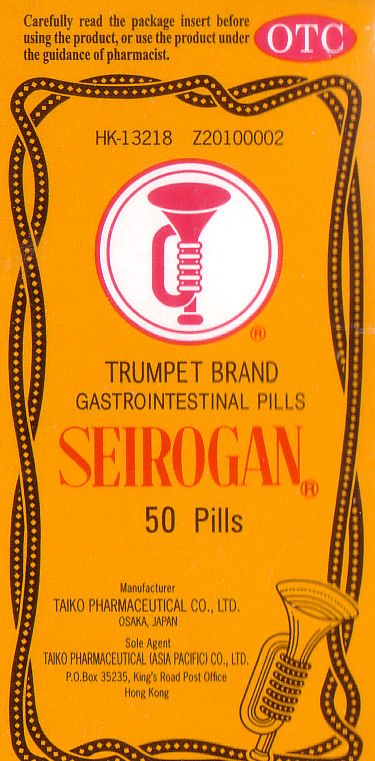 She returned with Baoji Wan, a product made in China. It had no English instructions and was not too effective either. After returning to the United States, we checked the web and learned the three soft black Seirogen pills we took three times a day did include wood creosote, an ancient stomach remedy. We also learned there that the Baoji Wan, also known as Po Chai, is something that Health Canada says not to take if it includes triclosen. We know not if it did or did not as the package and the insert had no English. Still desperately needing something, we did ingest three days worth of this buckshot-looking material that made a minimal amount of difference. One hour after landing at JFK, we went to a local drug store and purchased the drug we usually take in similar circumstances. In two hours it began to do the trick. Moral: Bring all items you think you may need and bring enough of them. She returned with Baoji Wan, a product made in China. It had no English instructions and was not too effective either. After returning to the United States, we checked the web and learned the three soft black Seirogen pills we took three times a day did include wood creosote, an ancient stomach remedy. We also learned there that the Baoji Wan, also known as Po Chai, is something that Health Canada says not to take if it includes triclosen. We know not if it did or did not as the package and the insert had no English. Still desperately needing something, we did ingest three days worth of this buckshot-looking material that made a minimal amount of difference. One hour after landing at JFK, we went to a local drug store and purchased the drug we usually take in similar circumstances. In two hours it began to do the trick. Moral: Bring all items you think you may need and bring enough of them.
From HILLARY in Westchester NY:
You did mention Pineapple Rice in the last issue but never gave a recipes; nor did you advise if it is rice in a pineapple or rice mixed with pineapple, or any other scenario. Please follow through, I love rice and I live fresh pineapple.
HILLARY: Sorry for the goof. Do read about a Dai restaurant in this issue that served us fried rice with pieces of fresh pineapple in one of these fruits in Kunming not too long ago. A recipe, but not theirs, follows, hope you enjoy it.
From JOSH via e-mail:
In your recipes, why do you use a capital ‘T’ for tablespoon and a small ‘t’ for teaspoon?
JOSH: We do that to help folks easily spot the measurement differences; we have done so since the earliest issues when our type was smaller and some folks had trouble telling the difference.
From MANY asking about ER KUAI
The pictures of Purchasing Er Kuai and seeing it made are after the recipes below.
| Deer Tendon Casserole |
|---|
Ingredients:
1/2 half pound deer tendon
1 dried shrimp, soaked for half an hour, then minced
1 dried scallop, soaked for half an hour, then simmered in half cup water one hour, then shredded
3 Chinese black mushrooms, soaked twenty minutes, stems discarded, and quartered
1/2 cup chicken, ham, or pork, slivered
1 cup chicken stock
1 small green pepper, spicy or not, diced
1 Tablespoon Chinese rice wine
2 Tablespoons cornstarch mixed with one tablespoon cold water
1 teaspoon chicken fat or lard
1/2 teaspoon salt
Preparation:
1. Cut deer tendon into one inch by two inch pieces, then blanch it for one minute in boiling water, then drain and let it cool.
2. Repeat this twice, and after it cools that third time, add the meat, chicken stock, prepared shrimp and scallop shreds, black mushroom and pepper pieces and simmer until tendons are tender.
3. Add the cornstarch mixture, rice wine, lard, and salt and bring to the boil. When thickened, serve on a re-heated platter or bowl.
|
| Braised Ox Tendon |
|---|
Ingredients:
1/2 pound ox tendon
1/2 cup shelled peanuts, paper exteriors removed
1/4 cup peeled and diced carrots
2 Tablespoons angle-sliced leek, green part only
1 Tablespoon peeled and diced fresh ginger
6 shallots, peeled then cut in half
1 dried chili pepper, cut in half, seeds discarded
1/2 teaspoon Sichuan peppercorns
1 Tablespoon powdered chicken extract
1 teaspoon sugar
1 Tablespoon black vinegar
1 Tablespoon Chinese rice wine
1 teaspoon sesame oil
1 Tablespoon thin soy sauce
2 teaspoons vegetable oil
1 Tablespoon cornstarch mixed with one tablespoon cold water
Preparation:
1. Blanch ox tendon for one minute in boiling water, drain, and cool, and repeat once more when cooled.
2. Put prepared peanuts, carrots, leeks, ginger, shallots, chili pepper in a small bowl.
3. In another bowl, mix Sichuan peppercorns chicken extract, sugar, vinegar, rice wine, sesame oil, and the soy sauce.
4. Heat vegetable oil then add tendon mixture and stir-fry for three minutes or until tendon is soft, then add the contents of the other bowl and simmer for five more minutes.
5. Add cornstarch mixture and stir until thickened. Transfer to a platter, and serve.
|
| Pan-fried Silk Squash |
|---|
Ingredients:
1 silk squash, about half a pound
2 Tablespoons vegetable oil, divided
1 scallion, minced
1/4 cup chicken or vegetable stock
2 Tablespoons shelled peanuts, paper coverings removed
1 large clove garlic, peeled and minced
4 eggs, beaten until a light lemon color
Preparation:
1. Using a peeler, remove ridges from the entire length of the silk squash, then cut it into eight pieces, and cut these into a dozen strips.
2. Heat half the oil and stir-fry the scallions pieces until fragrant, then add the silk squash and stir fry for one minute before adding the chicken stock and bringing to the boil, then immediately remove all to a bowl.
3. Add the remaining tablespoon of oil and stir-fry the garlic and peanuts for two minutes.
4. Return the silk squash and stock and then add in the beaten eggs; and using a pair of chopsticks, stir the mixture until the eggs begin to set.
5. Turn the eggs over with a spatula, and stir again with the chopsticks for another minute, then serve on a pre-heated plate.
|
| Fried Rice and Seaood in a Pineapple |
|---|
Ingredients:
8 small squid, cartilage and heads removed, cut into half-inch pieces
1 fresh pineapple, square top removed and discarded, frond left on, fruit hollowed out
3 cups cooled cooked rice
1/4 pound fresh shrimp, peel and veins removed, cut into half-inch pieces
1 medium onion, diced
1/4 cup fresh crab meat, cartilage removed and cut into half-inch pieces
1/2 red and 1/2 green pepper, each cut into half-inch pieces
3 Tablespoons golden raisons, plumped in boiling water
1 Tablespoon vegetable oil
1/2 Tablespoon curry powder
1 teaspoon sugar
1 Tablespoon thin soy sauce
1 Tablespoon oyster sauce
1/2 teaspoon ground white pepper
Preparation:
1. Drop squid into boiling water and after one minute, remove, put in ice water for one minute, then drain and set aside.
2. Hollow out the pineapple then cut the part taken out into one-half to one-inch pieces, mix with the rice and the squid, then set these aside.
3. Put the shrimp and the crab meat into boiling water for one minute, drain, put into ice water for half minute, then drain them and mix with the pineapple rice mixture.
4. Mix red and green peppers and the raisons and mix them with the pineapple rice, as well.
5. Heat oil in a wok or fry-pan, add curry powder and stir for two minutes, then add the sugar, and the soy and oyster sauces, Stir-fry another two minutes add the ground white pepper and stir well, then add the pineapple rice mixture and stir-fry for two minutes making sure all is very hot.
6. Pour two cups of boiling water into the pineapple, then pour it out discarding the water and putting the hot pineapple rice mixture into the pre-heated pineapple, and serve.
|
Making Er Kuai
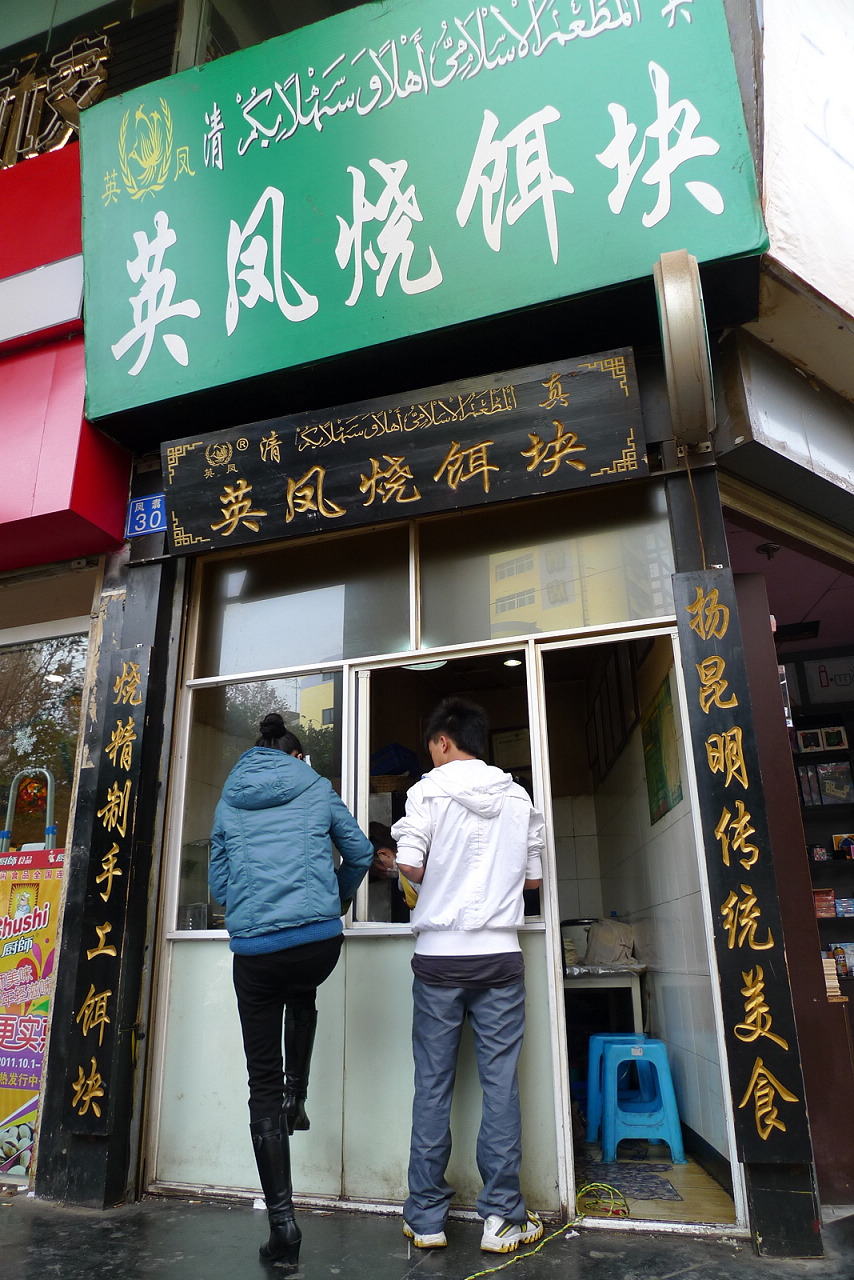
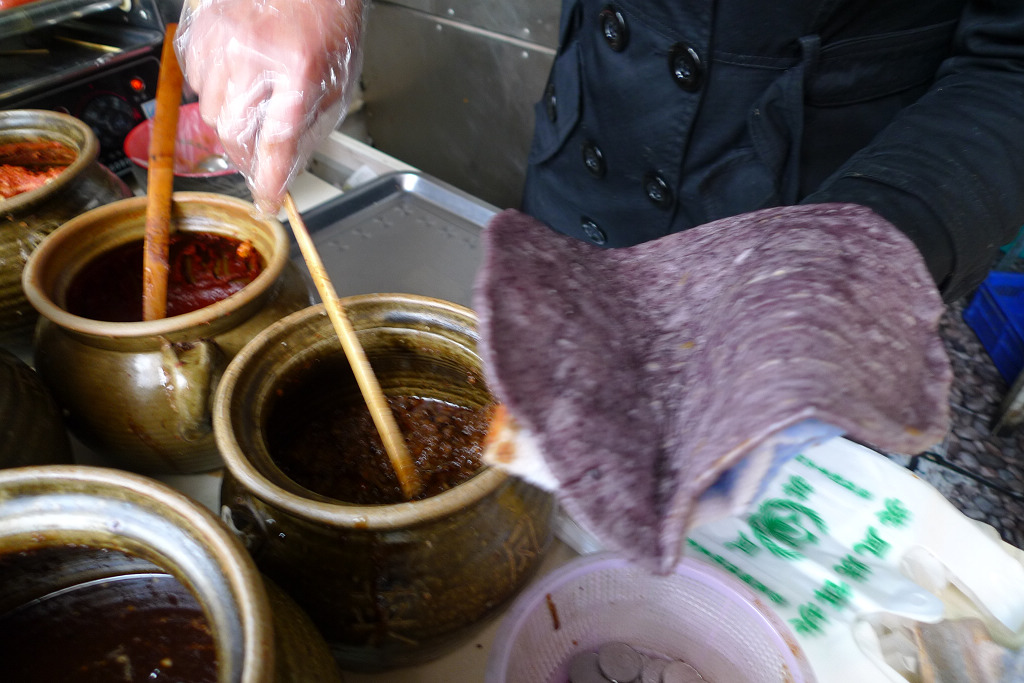

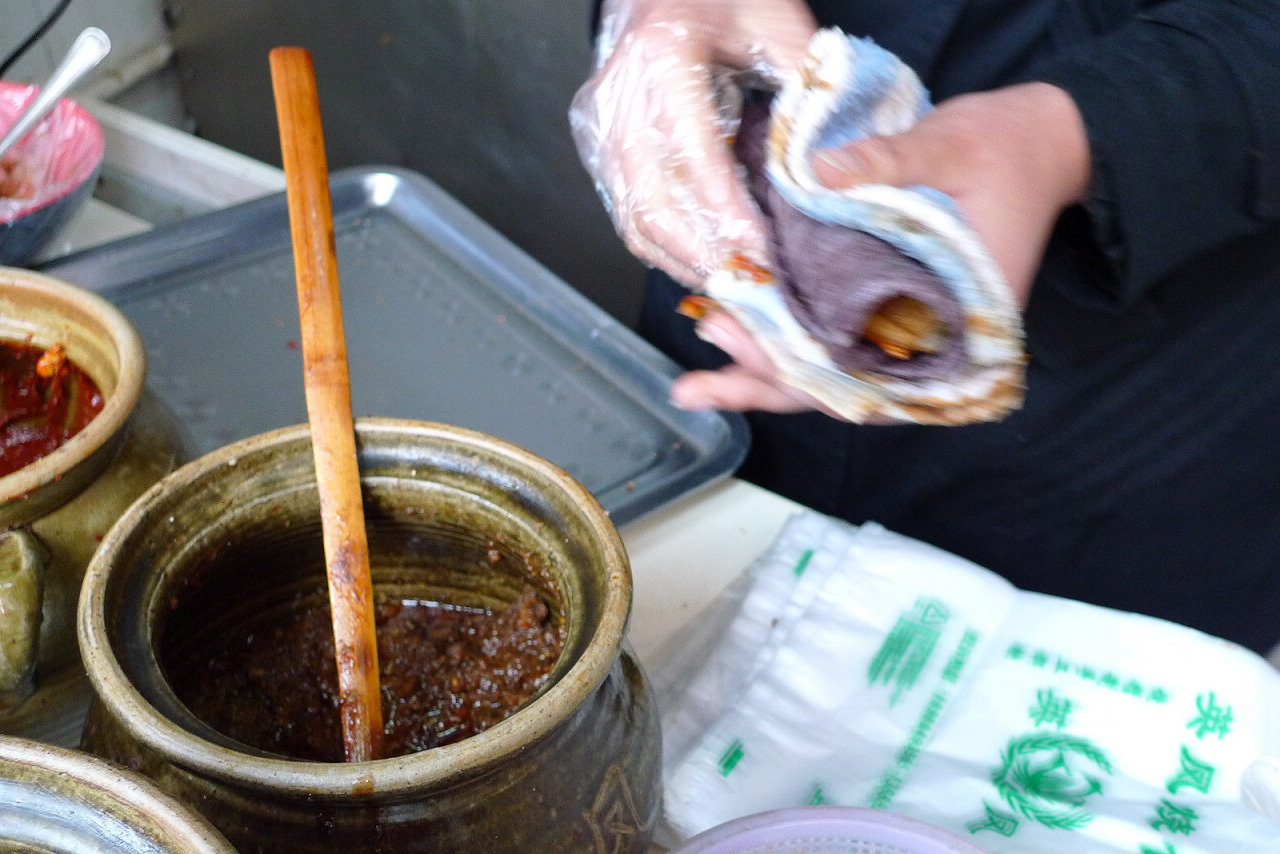 |

MARRETTE: Your question could not be more timely. Recently, at M & T Restaurant in Flushing, we ordered a dish with beef tendons but were told they only had pork tendons in house. Never had them from pig before, so we order that dish and learn they are delicious. A long time ago, we did eat deer tendon in China and did get a recipe for it in Xian. However, we never used it because we could not find any deer tendons on Long Island. Here is that recipe and another for a braised ox tendon dish we did make about a year ago. Enjoy both!

 She returned with Baoji Wan, a product made in China. It had no English instructions and was not too effective either. After returning to the United States, we checked the web and learned the three soft black Seirogen pills we took three times a day did include wood creosote, an ancient stomach remedy. We also learned there that the Baoji Wan, also known as Po Chai, is something that Health Canada says not to take if it includes triclosen. We know not if it did or did not as the package and the insert had no English. Still desperately needing something, we did ingest three days worth of this buckshot-looking material that made a minimal amount of difference. One hour after landing at JFK, we went to a local drug store and purchased the drug we usually take in similar circumstances. In two hours it began to do the trick. Moral: Bring all items you think you may need and bring enough of them.
She returned with Baoji Wan, a product made in China. It had no English instructions and was not too effective either. After returning to the United States, we checked the web and learned the three soft black Seirogen pills we took three times a day did include wood creosote, an ancient stomach remedy. We also learned there that the Baoji Wan, also known as Po Chai, is something that Health Canada says not to take if it includes triclosen. We know not if it did or did not as the package and the insert had no English. Still desperately needing something, we did ingest three days worth of this buckshot-looking material that made a minimal amount of difference. One hour after landing at JFK, we went to a local drug store and purchased the drug we usually take in similar circumstances. In two hours it began to do the trick. Moral: Bring all items you think you may need and bring enough of them.
